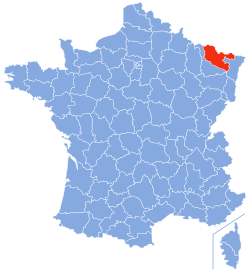Moselle (department)
| Moselle | ||
|---|---|---|
| Department | ||

Prefecture building of the Moselle department, in Metz
|
||
|
||
 Location of Moselle in France |
||
| Coordinates: 49°02′02″N 6°39′43″E / 49.03389°N 6.66194°ECoordinates: 49°02′02″N 6°39′43″E / 49.03389°N 6.66194°E | ||
| Country | France | |
| Region | Grand Est | |
| Prefecture | Metz | |
| Subprefectures |
Château-Salins Forbach Sarrebourg Sarreguemines Thionville |
|
| Government | ||
| • President of the General Council | Philippe Leroy | |
| Area | ||
| • Total | 6,216 km2 (2,400 sq mi) | |
| Population (2013) | ||
| • Total | 1,046,873 | |
| • Rank | 21st | |
| • Density | 170/km2 (440/sq mi) | |
| Time zone | CET (UTC+1) | |
| • Summer (DST) | CEST (UTC+2) | |
| Department number | 57 | |
| Arrondissements | 5 | |
| Cantons | 27 | |
| Communes | 729 | |
| ^1 French Land Register data, which exclude estuaries, and lakes, ponds, and glaciers larger than 1 km2 | ||
Moselle (French pronunciation: [mɔ.zɛl]) is the most populous department in Lorraine, in the east of France, and is named after the river Moselle, a tributary of the Rhine, which flows through the western part of the department. Inhabitants of the department are known as Mosellans.
Moselle is one of the original 83 departments created during the French Revolution on March 4, 1790. It was created from the former province of Lorraine.
In 1793 France annexed the enclaves of Manderen, Lixing-lès-Rouhling, Momerstroff, and Créhange (Kriechingen) - all possessions of princes of the Duchy of Luxemburg - a state of the Holy Roman Empire, and incorporated them into the Moselle département. One of its first prefects was the comte de Vaublanc, from 1805 to 1814.
By the Treaty of Paris of 1814 following the first defeat and abdication of Napoleon, France had to surrender almost all the territory it had conquered since 1792. In northeastern France, the Treaty did not restore the 1792 borders, however, but defined a new frontier to put an end to the convoluted nature of the border, with all its enclaves and exclaves. As a result, France ceded the exclave of Tholey (now in Saarland, Germany) as well as a few communes near Sierck-les-Bains (both territories until then part of the Moselle département) to Austria. On the other hand, the Treaty confirmed the French annexations of 1793, and furthermore, the south of the Napoleonic département of Sarre was ceded to France, including the town of Lebach, the city of Saarbrücken, and the rich coal basin nearby. France thus became a net beneficiary of the Treaty of Paris: all the new territories ceded to her being far larger and more strategic than the few territories ceded to Austria. All these new territories were incorporated into the Moselle department, and so Moselle had now a larger territory than ever since 1790.
...
Wikipedia

